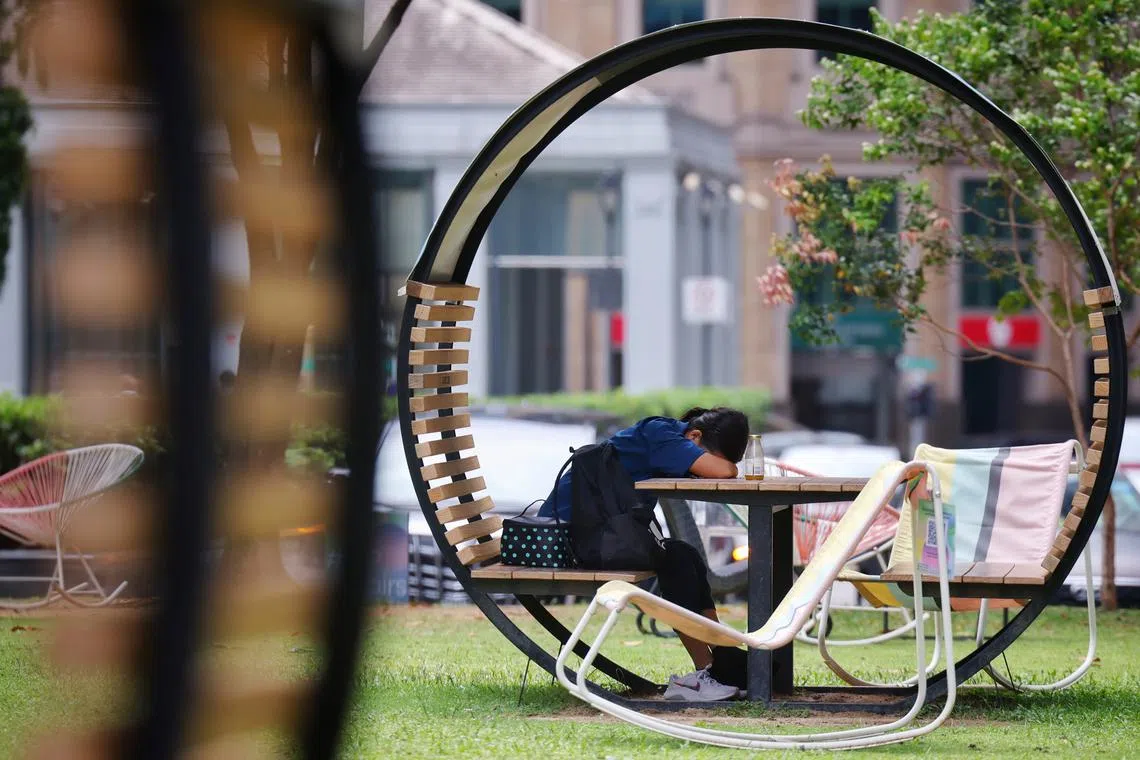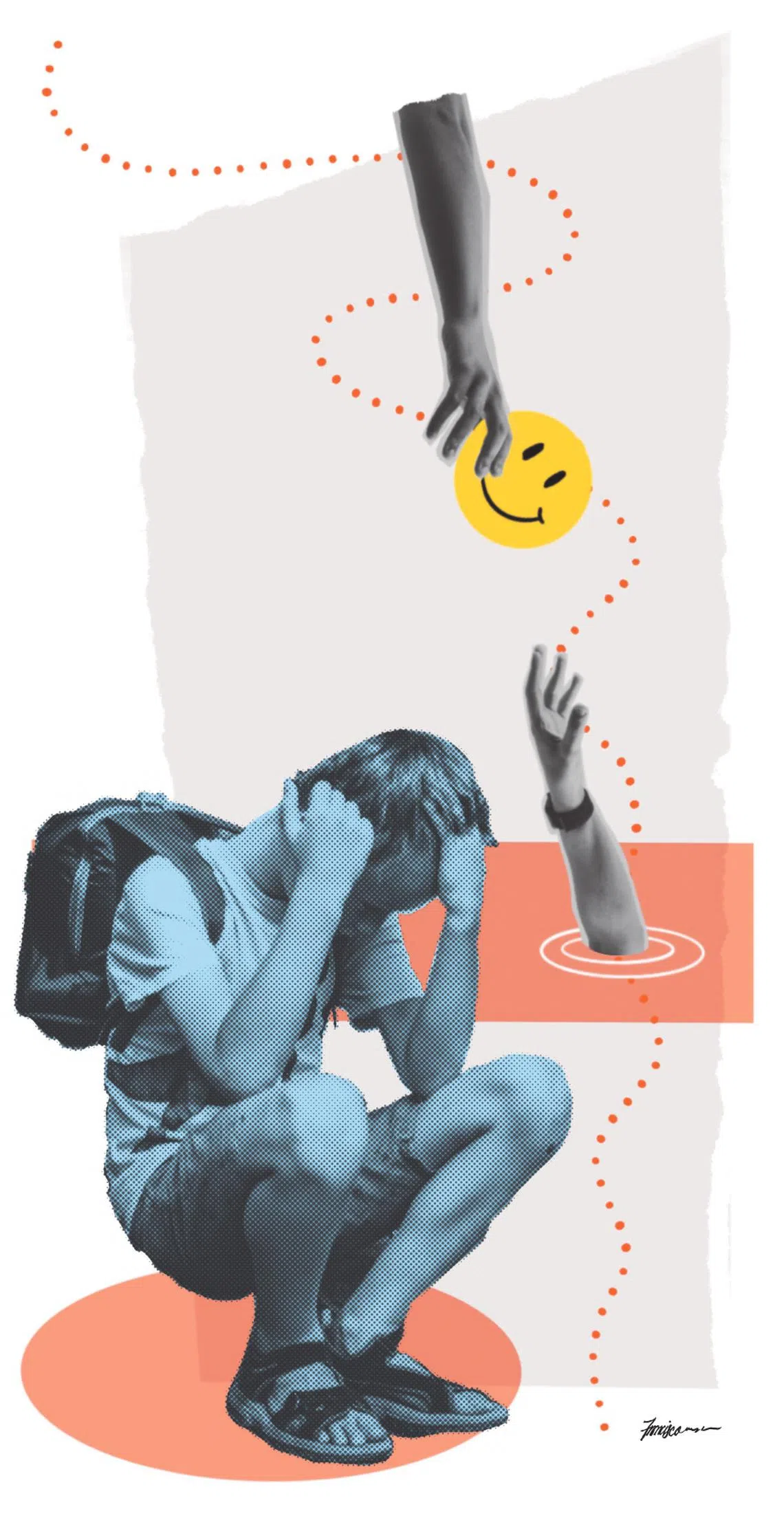No health without mental health
Youth mental health – an impending growing crisis
Sign up now: Get ST's newsletters delivered to your inbox

A significant contributor to youth mental health is the relentless pressure to succeed academically and professionally.
ST PHOTO: JASON QUAH
Mythily Subramaniam
Follow topic:
A few years ago, I sat at my dining table looking at my blood pressure machine in a state of complete shock. My readings were way above normal. I had a few risk factors, but I had a fairly healthy lifestyle, and while life had been stressful due to personal and work-related factors, I did not expect this.
The disbelief lasted all of 15 seconds. I decided to repeat the reading over the next two weeks and take myself to the general practitioner if it persisted. It did, and my physician subsequently prescribed anti-hypertensive medication.
My clinician friends commiserated, but everyone decided I was at that “age”, and many of us would eventually have this problem. They were right: A study funded by the World Health Organisation showed that in 2019, the global age-standardised prevalence of hypertension in adults aged 30 to 79 was 32 per cent in women. Closer to home, the National Population Health Survey
I can’t help but compare my experience with that of young people dealing with mental health conditions. Many believe that their feelings of anxiety and low mood will go away (and they sometimes do, as not every episode of low mood is a harbinger of depression), so they wait months, or even years, hoping against hope that it is a passing phase.
When they finally gather the courage to talk to their parents, many report that their feelings are dismissed. A young girl told me her mother asked her what made her feel low. Her confession about a broken relationship, body image concerns, and low self-esteem took her mother by surprise.
Her mother had struggled in her life with financial hardships, while providing for her children and parents. If she were resilient enough, she could not understand why her daughter could not overcome these seemingly – at least to her – minor hurdles.
Another young man told us that neither he nor the people in his social network considered his low moods as something that needed treatment. It was when he expressed suicidal thoughts that people managed to convince him to seek treatment.
Whether these young people will finally seek formal help and talk about it to their friends and colleagues merits a separate discussion. Not surprisingly, local studies that report a high prevalence of mental health problems are met with similar disbelief, despite global evidence to the contrary.
The growing crisis
In the past decade, the topic of youth mental health has evolved from being a quiet conversation among health professionals and concerned and often affected parents to a pressing global concern. In the recent Lancet Commission (an international and multidisciplinary collaboration), Australian psychiatrist Patrick McGorry and colleagues argue that “being a young person navigating the transition to mature adulthood today is very different than it was even 20 years ago”, and provide compelling evidence pointing to a serious decline in the mental health of young people in high-income countries. They predict that with globalisation, these trends would be equally relevant to low- and middle-income countries.
Mental health issues among young people have soared – the World Health Organisation estimates that one in seven 10- to 19-year-olds experiences a mental disorder, accounting for 15 per cent of the global burden of disease in this age group, while suicide remains one of the leading causes of death among those aged 15 to 24.
Youth is a crucial period of growth characterised by immense biological, physical, cognitive, social, and emotional changes. A complex interplay of factors determines youth mental health, each contributing uniquely to how young people experience stress, develop resilience, and navigate life’s challenges.
A colleague at work often uses the transactional model of stress and coping to explain distress. The model describes how individuals respond to and manage stress through a process of evaluating the stressor and assessing available coping resources. In the primary appraisal stage, individuals determine if a situation is indeed stressful. If it is, a secondary appraisal follows, and an evaluation of whether they have sufficient resources to manage the stress. When individuals deem resources insufficient, they consider coping options.
Effective coping strategies can reduce stress impact, while ineffective coping may contribute to negative mental health effects. Thus, the model emphasises the role of individual perception, resource availability, and coping strategies in determining stress outcomes. Looking at youth mental health through this lens makes it easier to understand that what is stressful to them may not be stressful to adults; they often lack resources to deal with the stress and often employ poor coping strategies, as it is a skill that accrues with age and life experiences and lessons.

ST ILLUSTRATION: MANNY FRANCISCO
Youth-specific stressors
Social media users are primarily young people, who spend significantly more time online and are more vulnerable to its influences. Although social media is not inherently harmful, it encourages comparisons. Young people constantly see curated highlights of other people’s lives, leading to feelings of inadequacy.
Research further suggests that social media’s interactive nature and content –characterised by a strong peer presence and the constant sharing of visual images – can impact body image concerns. The constant need to check social media updates and stay connected (virtually) leads to excessive screen time and sleep disruption.
Sleep deprivation, in turn, is associated with irritability, poor cognitive performance, and mental health issues. Cyber bullying or online harassment is yet another stressor associated with the digital world. It can be devastating, pervasive, and sadly missed by adults until very late. Unlike in-person bullying, cyber bullying can follow young people into their homes, making it feel ever-present and leading to depression and anxiety.
Another significant contributor to youth mental health is the relentless pressure to succeed academically and professionally. Today’s youth feel compelled to excel in school, which can mean high levels of stress and a lack of time for relaxation, hobbies, or social interaction.
Surprisingly, the pressure does not come from parents alone; young people have high self-expectations, and there is peer expectation, too, with many worrying that their peers will not remain friends if they do not perform well academically.
As schools, colleges, and universities formally or informally have a ranking system, the pressure to not be in a “low-ranking academic institution” can be overwhelming. The growing “gig economy”, increased youth unemployment (in some countries), and reduced job stability further exacerbate these concerns, creating a sense of financial insecurity that weighs heavily on young minds.
Much has already been said about the Covid-19 pandemic, which was the proverbial last straw for an already-developing mental health crisis. The social isolation, uncertainty, and disruption to schooling and other familiar routines had a profound impact on young people’s mental well-being.
For many, this meant the loss of milestones such as the celebratory graduation ceremony, first job, and other formative experiences that mark the transition to adulthood. Older adults who had experienced pandemics and other stressful world events not surprisingly had better coping skills, and the predicted tsunami of poor mental health affected young people disproportionately.
Several other stressors are perceived more acutely by young people. In a survey of 10,000 children and young people examining climate anxiety in more than 10 countries, more than 50 per cent reported emotions of sadness, anxiety, anger, feeling powerless, helplessness, and guilt.
More than 45 per cent of respondents said their feelings about climate change negatively affected their daily life and functioning, 75 per cent said they think the future is frightening, and 83 per cent said people have failed to care for the planet. I have often wondered how adults and older adults would respond to a similar survey.
Looking towards solutions
Addressing the youth mental health crisis requires a multi-faceted approach, combining individual support, community efforts, research, and policy change. Parents should be encouraged to have open conversations about mental health with their children, helping to reduce stigma and normalise seeking help. Many parents still believe that increased awareness and talking about taboo topics like suicide leads to the “planting of thoughts and the resultant behaviour”.
The uncomfortable truth is that we spend very little time with our children, and their views are influenced by a larger world that we often lack knowledge of. Our children need us as the voice of balanced reason and as a safe harbour where they can seek shelter when they are distressed. This is a responsibility we have to take on in their rapidly changing world.
Community programmes and youth organisations are other options that can offer safe spaces for young people to express themselves, find support, and develop resilience. Schools have a unique opportunity to support young people’s mental health. Given the amount of time students spend in school, these institutions can play a pivotal role in identifying and addressing mental health concerns. Mental health education should be integrated into school curricula, to help students recognise the signs of mental health issues and understand how to seek help.
Moreover, schools can provide access to counsellors and mental health resources, creating a supportive environment where students feel comfortable discussing their struggles. Several schools have implemented – and must continue to initiate – programmes that promote mental well-being, such as mindfulness, stress management, and peer support groups.

Additionally, technology can be used to create digital tools and platforms that provide mental health support, reaching young people who might not otherwise have access to help.
Communities can also advocate mental health resources, pushing for more funding for youth-focused programmes, and more mental health education. While there is a positive trend in Singapore of individuals and community groups actively advocating evidence-based youth interventions, more can and should be done.
Lastly, there is a need for greater research into the risk and protective factors, as well as the effectiveness of treatment of mental health issues in young people. While many of the factors contributing to youth mental health issues are well known, understanding the full range of influences and how they interact in Singapore’s multi-ethnic, highly connected, highly driven youth can lead to more effective interventions. What works and for whom it works is an area that needs deeper research and investment.
The youth mental health crisis is a complex and emerging issue that requires immediate and sustained attention and action. With poorly regulated social media, academic pressures, economic uncertainties, and uncontrollable global issues buffeting our young people, it is essential that we adults should act like adults to provide that safe refuge, and to advocate and even demand more and better mental health support and services.
Youth mental health is an impending global crisis and the time to act is now.
Dr Mythily Subramaniam is assistant chairman of the medical research board at the Institute of Mental Health and an associate professor at the Saw Swee Hock School of Public Health.
Helplines
Mental well-being
Institute of Mental Health’s Mental Health Helpline: 6389-2222 (24 hours)
Samaritans of Singapore: 1-767 (24 hours) / 9151-1767 (24-hour CareText via WhatsApp)
Singapore Association for Mental Health: 1800-283-7019
Silver Ribbon Singapore: 6386-1928
Tinkle Friend: 1800-274-4788
Chat, Centre of Excellence for Youth Mental Health: 6493-6500/1
Women’s Helpline (Aware): 1800-777-5555 (weekdays, 10am to 6pm)
Counselling
Touchline (Counselling): 1800-377-2252
Touch Care Line (for caregivers): 6804-6555
Care Corner Counselling Centre: 6353-1180
Counselling and Care Centre: 6536-6366
We Care Community Services: 3165-8017
Online resources
carey.carecorner.org.sg
(for those aged 13 to 25)limitless.sg/talk
(for those aged 12 to 25)

